Business Administration Report on Office Management and Operations
VerifiedAdded on 2021/01/02
|13
|4347
|462
Report
AI Summary
This report provides a comprehensive overview of business administration principles, with a specific focus on office management. It explores legal requirements related to office facilities, detailing aspects such as the Equality Act 2010 and the Employment Rights Act 1996, emphasizing the importance of fair treatment and employee rights. The report outlines typical office services, including bookkeeping, travel arrangements, and mail handling. It discusses establishing office management procedures, managing office resources (equipment, staff, materials), and techniques for monitoring and managing workflows. Furthermore, the report examines legal obligations for health and safety in the workplace, individual responsibilities, and accident and emergency procedures. It also delves into the purpose and legal implications of meeting minutes, accuracy in minute-taking, and the contents of different meeting types. Techniques for facilitating meetings, event planning, and the use of targets and budgets for managing workloads are also discussed. The report concludes with an analysis of event characteristics, information requirements, and resource identification within an event plan.
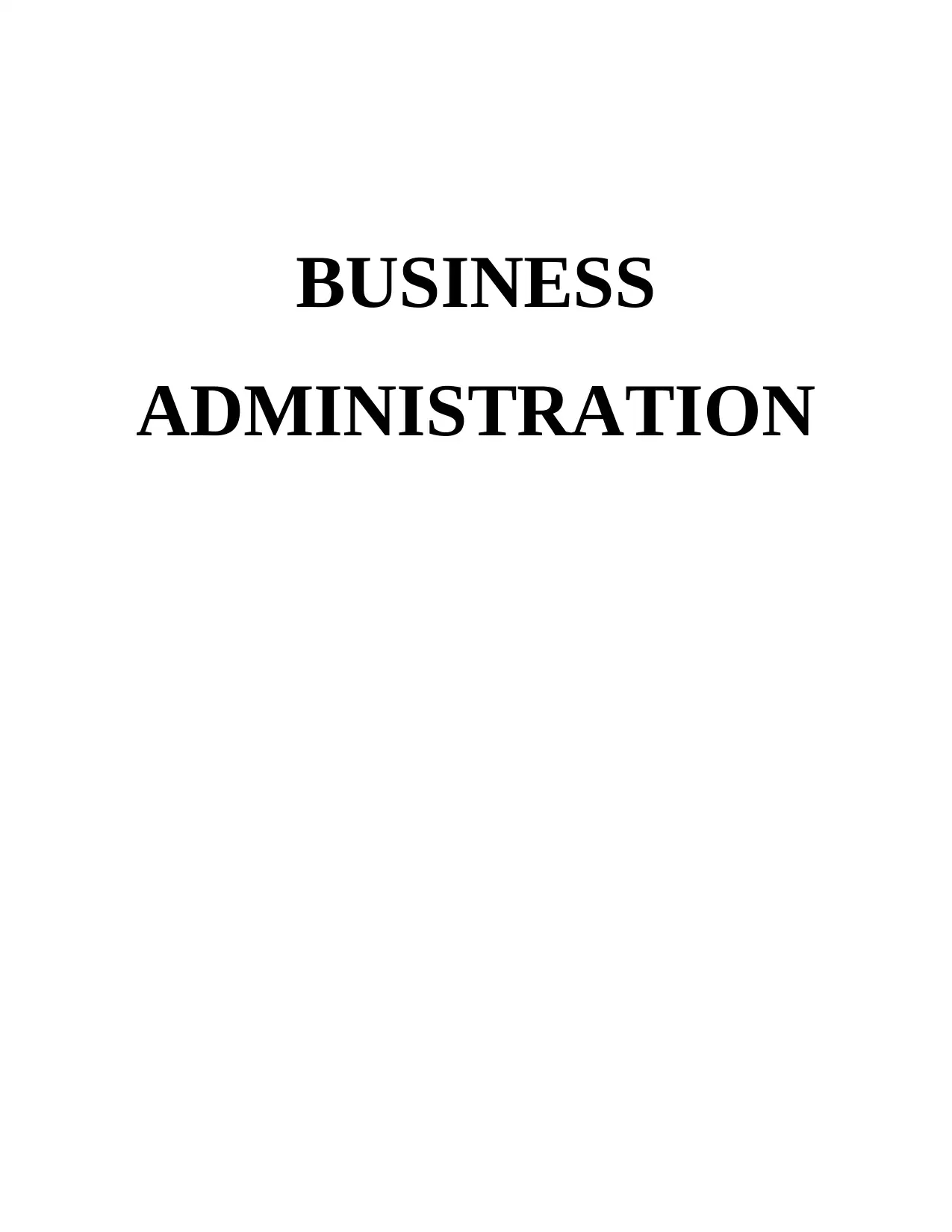
BUSINESS
ADMINISTRATION
ADMINISTRATION
Paraphrase This Document
Need a fresh take? Get an instant paraphrase of this document with our AI Paraphraser

Table of Contents
INTRODUCTION...........................................................................................................................1
MAIN BODY...................................................................................................................................1
1.1 Legal requirements relating to the management of office facilities.....................................1
1.2 Describe the typical services provided by an office facility..................................................1
1. 3 How to establish office management procedures.................................................................2
1. 4 Explain how to manage office resources..............................................................................2
1. 5 Techniques to monitor and manage work flows...................................................................2
1.6 Explain typical support and welfare facilities for office workers..........................................2
2. 1 Explain the legal obligations of the employer for health and safety in the workplace.........3
2. 2 Explain an individual’s responsibilities for health and safety in the workplace...................3
2.3 Describe accident and emergency procedures.......................................................................3
3.1 Purpose of meeting minutes...................................................................................................1
3.2 The legal implications of meeting minutes............................................................................1
3.3 The importance of accuracy in minute taking........................................................................1
3.4 Describe what should and should not be included in different types of meeting minutes.....2
3.5 How to take notes during meetings........................................................................................2
4.1 Features and purpose of different types of formal and informal meeting..............................2
4.2 Role and responsibilities of the chair.....................................................................................3
4.3 Role of others in a meeting....................................................................................................3
4.4 Techniques to facilitate a meeting.........................................................................................3
4.5 Information requirements of a meeting before, during and after a meeting..........................4
5.1 & 5.2 Explain the Use of targets and budgets .......................................................................4
5.3 Quality management techniques to manage the performance...............................................4
5.4 Techniques used to identify the need for improvements in team outputs and standards.......4
6.1 Characteristics, requirements and purposes of different types of events...............................5
6.2 Types of information and information sources needed to organise an event........................5
6.3 Explain how to plan an event.................................................................................................5
6.4 Explain how to identify the right resources from an event plan............................................6
INTRODUCTION...........................................................................................................................1
MAIN BODY...................................................................................................................................1
1.1 Legal requirements relating to the management of office facilities.....................................1
1.2 Describe the typical services provided by an office facility..................................................1
1. 3 How to establish office management procedures.................................................................2
1. 4 Explain how to manage office resources..............................................................................2
1. 5 Techniques to monitor and manage work flows...................................................................2
1.6 Explain typical support and welfare facilities for office workers..........................................2
2. 1 Explain the legal obligations of the employer for health and safety in the workplace.........3
2. 2 Explain an individual’s responsibilities for health and safety in the workplace...................3
2.3 Describe accident and emergency procedures.......................................................................3
3.1 Purpose of meeting minutes...................................................................................................1
3.2 The legal implications of meeting minutes............................................................................1
3.3 The importance of accuracy in minute taking........................................................................1
3.4 Describe what should and should not be included in different types of meeting minutes.....2
3.5 How to take notes during meetings........................................................................................2
4.1 Features and purpose of different types of formal and informal meeting..............................2
4.2 Role and responsibilities of the chair.....................................................................................3
4.3 Role of others in a meeting....................................................................................................3
4.4 Techniques to facilitate a meeting.........................................................................................3
4.5 Information requirements of a meeting before, during and after a meeting..........................4
5.1 & 5.2 Explain the Use of targets and budgets .......................................................................4
5.3 Quality management techniques to manage the performance...............................................4
5.4 Techniques used to identify the need for improvements in team outputs and standards.......4
6.1 Characteristics, requirements and purposes of different types of events...............................5
6.2 Types of information and information sources needed to organise an event........................5
6.3 Explain how to plan an event.................................................................................................5
6.4 Explain how to identify the right resources from an event plan............................................6
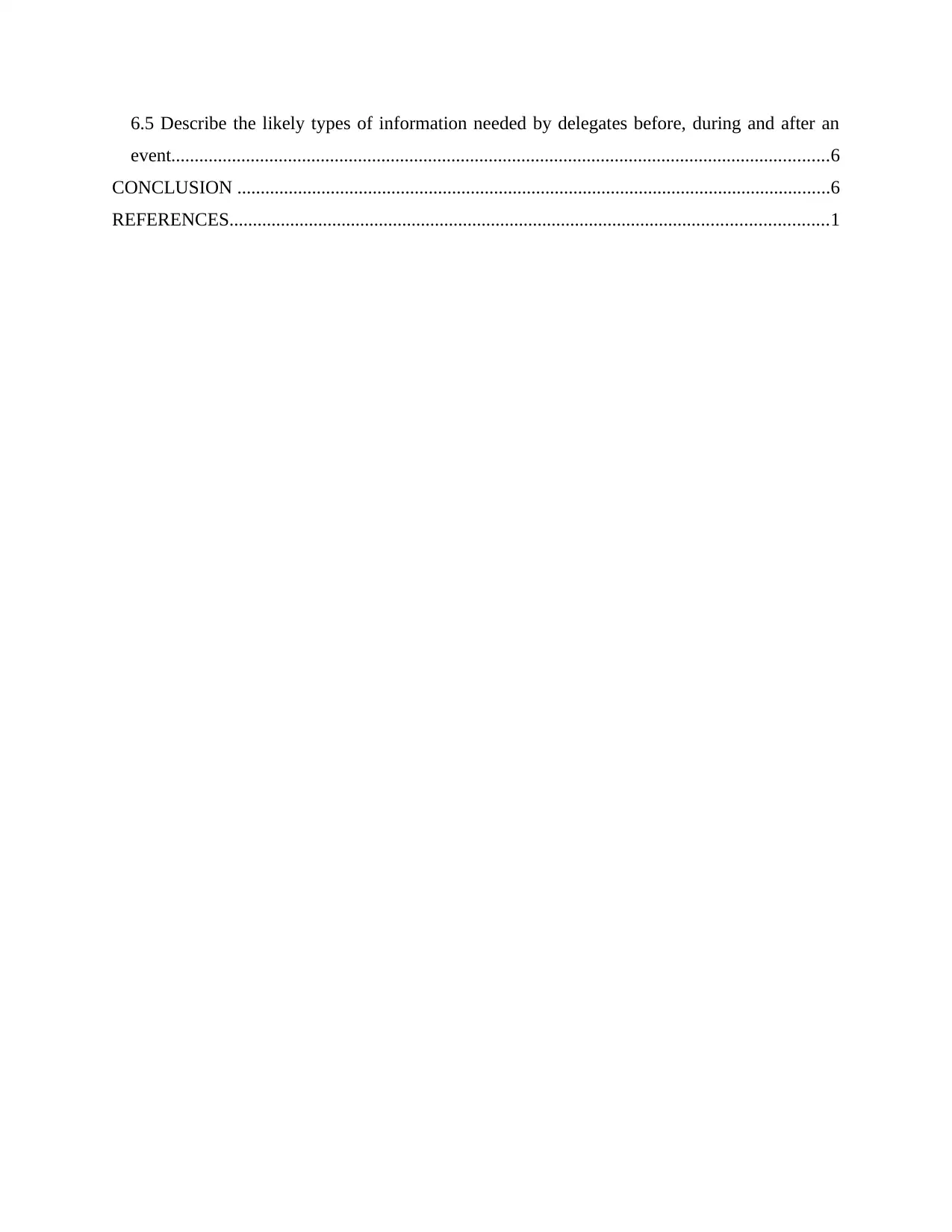
6.5 Describe the likely types of information needed by delegates before, during and after an
event.............................................................................................................................................6
CONCLUSION ...............................................................................................................................6
REFERENCES................................................................................................................................1
event.............................................................................................................................................6
CONCLUSION ...............................................................................................................................6
REFERENCES................................................................................................................................1
⊘ This is a preview!⊘
Do you want full access?
Subscribe today to unlock all pages.

Trusted by 1+ million students worldwide
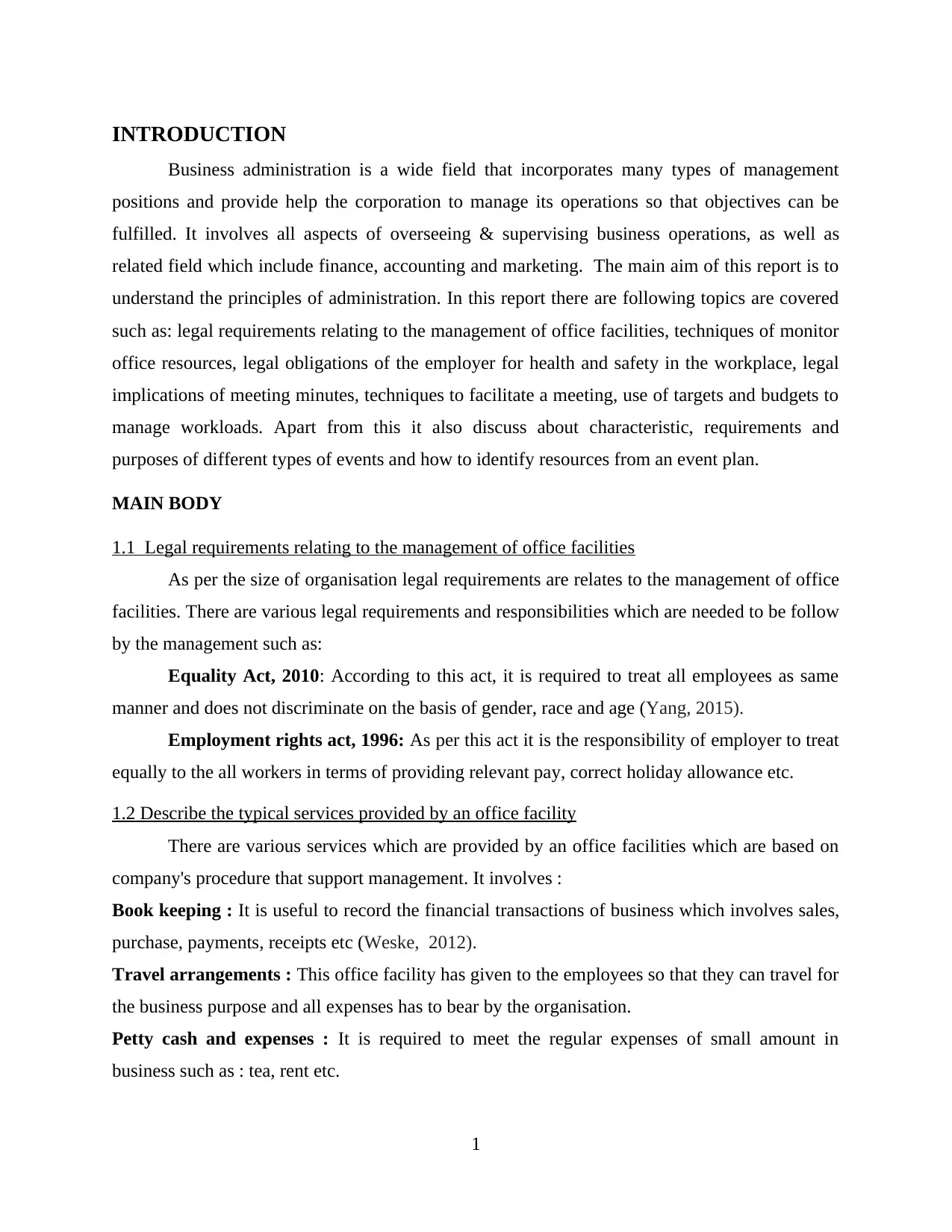
INTRODUCTION
Business administration is a wide field that incorporates many types of management
positions and provide help the corporation to manage its operations so that objectives can be
fulfilled. It involves all aspects of overseeing & supervising business operations, as well as
related field which include finance, accounting and marketing. The main aim of this report is to
understand the principles of administration. In this report there are following topics are covered
such as: legal requirements relating to the management of office facilities, techniques of monitor
office resources, legal obligations of the employer for health and safety in the workplace, legal
implications of meeting minutes, techniques to facilitate a meeting, use of targets and budgets to
manage workloads. Apart from this it also discuss about characteristic, requirements and
purposes of different types of events and how to identify resources from an event plan.
MAIN BODY
1.1 Legal requirements relating to the management of office facilities
As per the size of organisation legal requirements are relates to the management of office
facilities. There are various legal requirements and responsibilities which are needed to be follow
by the management such as:
Equality Act, 2010: According to this act, it is required to treat all employees as same
manner and does not discriminate on the basis of gender, race and age (Yang, 2015).
Employment rights act, 1996: As per this act it is the responsibility of employer to treat
equally to the all workers in terms of providing relevant pay, correct holiday allowance etc.
1.2 Describe the typical services provided by an office facility
There are various services which are provided by an office facilities which are based on
company's procedure that support management. It involves :
Book keeping : It is useful to record the financial transactions of business which involves sales,
purchase, payments, receipts etc (Weske, 2012).
Travel arrangements : This office facility has given to the employees so that they can travel for
the business purpose and all expenses has to bear by the organisation.
Petty cash and expenses : It is required to meet the regular expenses of small amount in
business such as : tea, rent etc.
1
Business administration is a wide field that incorporates many types of management
positions and provide help the corporation to manage its operations so that objectives can be
fulfilled. It involves all aspects of overseeing & supervising business operations, as well as
related field which include finance, accounting and marketing. The main aim of this report is to
understand the principles of administration. In this report there are following topics are covered
such as: legal requirements relating to the management of office facilities, techniques of monitor
office resources, legal obligations of the employer for health and safety in the workplace, legal
implications of meeting minutes, techniques to facilitate a meeting, use of targets and budgets to
manage workloads. Apart from this it also discuss about characteristic, requirements and
purposes of different types of events and how to identify resources from an event plan.
MAIN BODY
1.1 Legal requirements relating to the management of office facilities
As per the size of organisation legal requirements are relates to the management of office
facilities. There are various legal requirements and responsibilities which are needed to be follow
by the management such as:
Equality Act, 2010: According to this act, it is required to treat all employees as same
manner and does not discriminate on the basis of gender, race and age (Yang, 2015).
Employment rights act, 1996: As per this act it is the responsibility of employer to treat
equally to the all workers in terms of providing relevant pay, correct holiday allowance etc.
1.2 Describe the typical services provided by an office facility
There are various services which are provided by an office facilities which are based on
company's procedure that support management. It involves :
Book keeping : It is useful to record the financial transactions of business which involves sales,
purchase, payments, receipts etc (Weske, 2012).
Travel arrangements : This office facility has given to the employees so that they can travel for
the business purpose and all expenses has to bear by the organisation.
Petty cash and expenses : It is required to meet the regular expenses of small amount in
business such as : tea, rent etc.
1
Paraphrase This Document
Need a fresh take? Get an instant paraphrase of this document with our AI Paraphraser
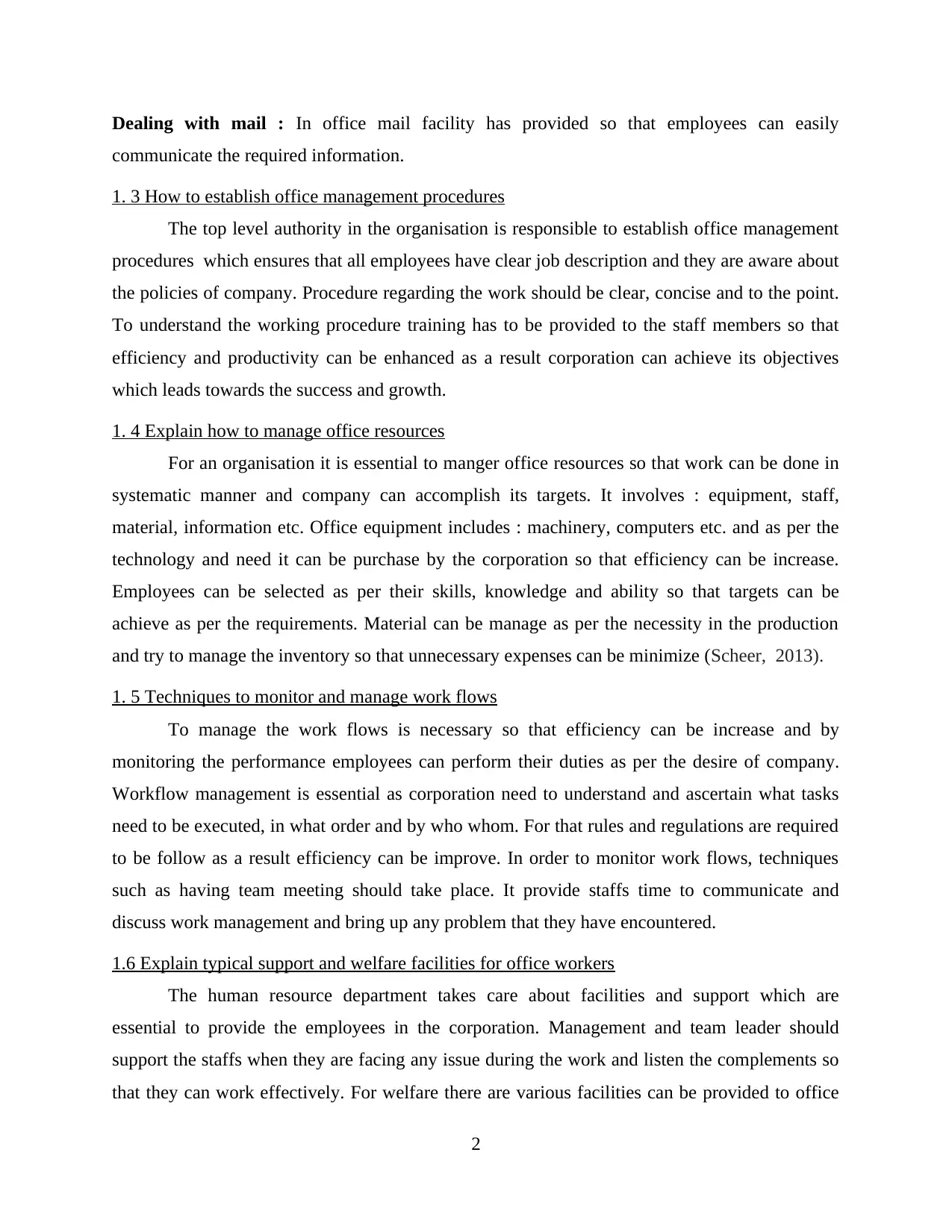
Dealing with mail : In office mail facility has provided so that employees can easily
communicate the required information.
1. 3 How to establish office management procedures
The top level authority in the organisation is responsible to establish office management
procedures which ensures that all employees have clear job description and they are aware about
the policies of company. Procedure regarding the work should be clear, concise and to the point.
To understand the working procedure training has to be provided to the staff members so that
efficiency and productivity can be enhanced as a result corporation can achieve its objectives
which leads towards the success and growth.
1. 4 Explain how to manage office resources
For an organisation it is essential to manger office resources so that work can be done in
systematic manner and company can accomplish its targets. It involves : equipment, staff,
material, information etc. Office equipment includes : machinery, computers etc. and as per the
technology and need it can be purchase by the corporation so that efficiency can be increase.
Employees can be selected as per their skills, knowledge and ability so that targets can be
achieve as per the requirements. Material can be manage as per the necessity in the production
and try to manage the inventory so that unnecessary expenses can be minimize (Scheer, 2013).
1. 5 Techniques to monitor and manage work flows
To manage the work flows is necessary so that efficiency can be increase and by
monitoring the performance employees can perform their duties as per the desire of company.
Workflow management is essential as corporation need to understand and ascertain what tasks
need to be executed, in what order and by who whom. For that rules and regulations are required
to be follow as a result efficiency can be improve. In order to monitor work flows, techniques
such as having team meeting should take place. It provide staffs time to communicate and
discuss work management and bring up any problem that they have encountered.
1.6 Explain typical support and welfare facilities for office workers
The human resource department takes care about facilities and support which are
essential to provide the employees in the corporation. Management and team leader should
support the staffs when they are facing any issue during the work and listen the complements so
that they can work effectively. For welfare there are various facilities can be provided to office
2
communicate the required information.
1. 3 How to establish office management procedures
The top level authority in the organisation is responsible to establish office management
procedures which ensures that all employees have clear job description and they are aware about
the policies of company. Procedure regarding the work should be clear, concise and to the point.
To understand the working procedure training has to be provided to the staff members so that
efficiency and productivity can be enhanced as a result corporation can achieve its objectives
which leads towards the success and growth.
1. 4 Explain how to manage office resources
For an organisation it is essential to manger office resources so that work can be done in
systematic manner and company can accomplish its targets. It involves : equipment, staff,
material, information etc. Office equipment includes : machinery, computers etc. and as per the
technology and need it can be purchase by the corporation so that efficiency can be increase.
Employees can be selected as per their skills, knowledge and ability so that targets can be
achieve as per the requirements. Material can be manage as per the necessity in the production
and try to manage the inventory so that unnecessary expenses can be minimize (Scheer, 2013).
1. 5 Techniques to monitor and manage work flows
To manage the work flows is necessary so that efficiency can be increase and by
monitoring the performance employees can perform their duties as per the desire of company.
Workflow management is essential as corporation need to understand and ascertain what tasks
need to be executed, in what order and by who whom. For that rules and regulations are required
to be follow as a result efficiency can be improve. In order to monitor work flows, techniques
such as having team meeting should take place. It provide staffs time to communicate and
discuss work management and bring up any problem that they have encountered.
1.6 Explain typical support and welfare facilities for office workers
The human resource department takes care about facilities and support which are
essential to provide the employees in the corporation. Management and team leader should
support the staffs when they are facing any issue during the work and listen the complements so
that they can work effectively. For welfare there are various facilities can be provided to office
2
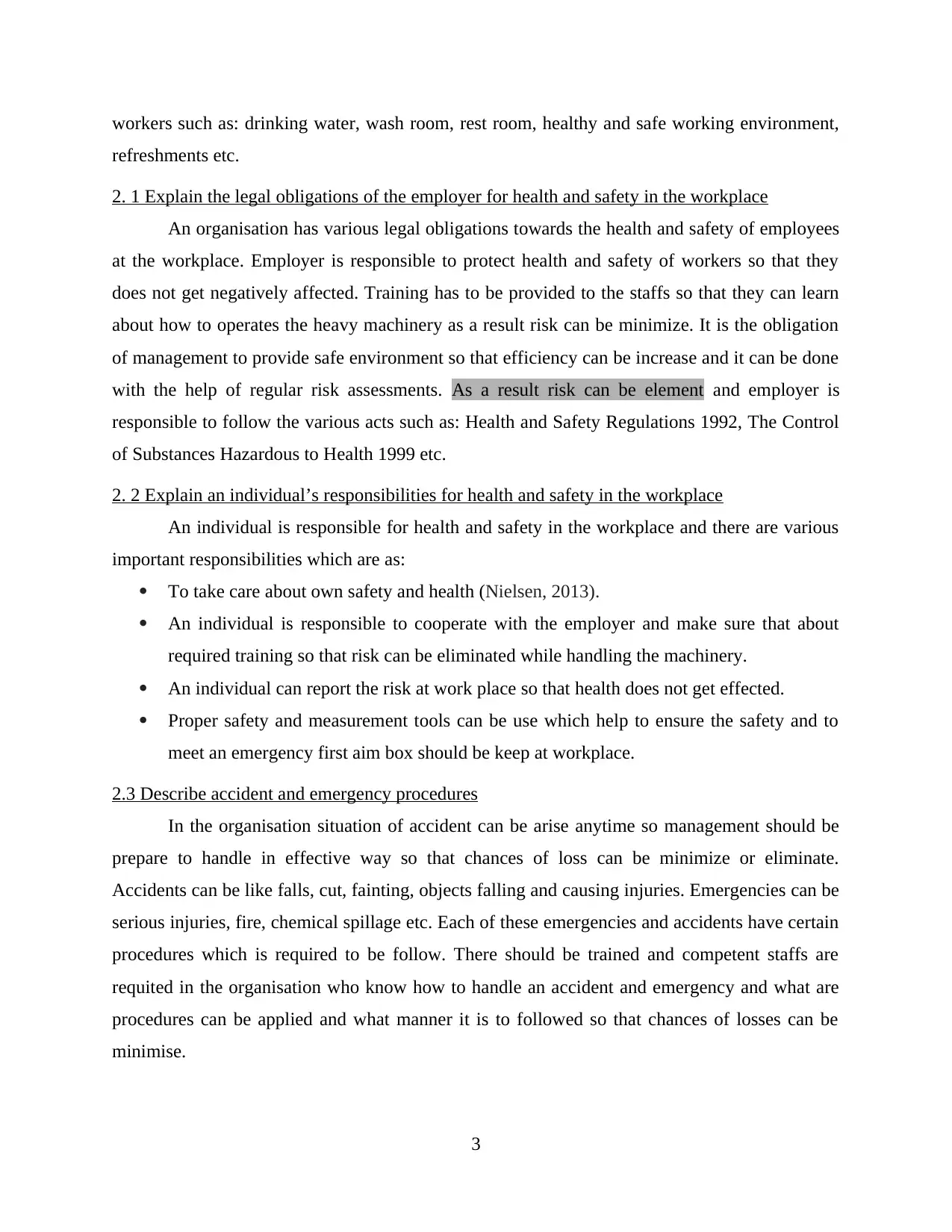
workers such as: drinking water, wash room, rest room, healthy and safe working environment,
refreshments etc.
2. 1 Explain the legal obligations of the employer for health and safety in the workplace
An organisation has various legal obligations towards the health and safety of employees
at the workplace. Employer is responsible to protect health and safety of workers so that they
does not get negatively affected. Training has to be provided to the staffs so that they can learn
about how to operates the heavy machinery as a result risk can be minimize. It is the obligation
of management to provide safe environment so that efficiency can be increase and it can be done
with the help of regular risk assessments. As a result risk can be element and employer is
responsible to follow the various acts such as: Health and Safety Regulations 1992, The Control
of Substances Hazardous to Health 1999 etc.
2. 2 Explain an individual’s responsibilities for health and safety in the workplace
An individual is responsible for health and safety in the workplace and there are various
important responsibilities which are as:
To take care about own safety and health (Nielsen, 2013).
An individual is responsible to cooperate with the employer and make sure that about
required training so that risk can be eliminated while handling the machinery.
An individual can report the risk at work place so that health does not get effected.
Proper safety and measurement tools can be use which help to ensure the safety and to
meet an emergency first aim box should be keep at workplace.
2.3 Describe accident and emergency procedures
In the organisation situation of accident can be arise anytime so management should be
prepare to handle in effective way so that chances of loss can be minimize or eliminate.
Accidents can be like falls, cut, fainting, objects falling and causing injuries. Emergencies can be
serious injuries, fire, chemical spillage etc. Each of these emergencies and accidents have certain
procedures which is required to be follow. There should be trained and competent staffs are
requited in the organisation who know how to handle an accident and emergency and what are
procedures can be applied and what manner it is to followed so that chances of losses can be
minimise.
3
refreshments etc.
2. 1 Explain the legal obligations of the employer for health and safety in the workplace
An organisation has various legal obligations towards the health and safety of employees
at the workplace. Employer is responsible to protect health and safety of workers so that they
does not get negatively affected. Training has to be provided to the staffs so that they can learn
about how to operates the heavy machinery as a result risk can be minimize. It is the obligation
of management to provide safe environment so that efficiency can be increase and it can be done
with the help of regular risk assessments. As a result risk can be element and employer is
responsible to follow the various acts such as: Health and Safety Regulations 1992, The Control
of Substances Hazardous to Health 1999 etc.
2. 2 Explain an individual’s responsibilities for health and safety in the workplace
An individual is responsible for health and safety in the workplace and there are various
important responsibilities which are as:
To take care about own safety and health (Nielsen, 2013).
An individual is responsible to cooperate with the employer and make sure that about
required training so that risk can be eliminated while handling the machinery.
An individual can report the risk at work place so that health does not get effected.
Proper safety and measurement tools can be use which help to ensure the safety and to
meet an emergency first aim box should be keep at workplace.
2.3 Describe accident and emergency procedures
In the organisation situation of accident can be arise anytime so management should be
prepare to handle in effective way so that chances of loss can be minimize or eliminate.
Accidents can be like falls, cut, fainting, objects falling and causing injuries. Emergencies can be
serious injuries, fire, chemical spillage etc. Each of these emergencies and accidents have certain
procedures which is required to be follow. There should be trained and competent staffs are
requited in the organisation who know how to handle an accident and emergency and what are
procedures can be applied and what manner it is to followed so that chances of losses can be
minimise.
3
⊘ This is a preview!⊘
Do you want full access?
Subscribe today to unlock all pages.

Trusted by 1+ million students worldwide

3.1 Purpose of meeting minutes
Meeting minutes is considered as a recorded or written documentation which is utilise to
inform individuals about the meeting and also explain the next planned step. Company can offer
legal protection and drive a action plan for its group as well as workers. Therefore the purpose of
meeting minutes is to records the accurate discussion that are carried out at the time of meetings
and also some activity are noted. Last minutes of meetings are discuss to know about the
outstanding actions. This may be utilise in legal conditions and considered as evidence in order
to solve the conflict in work. It is also data for employees which can not able to attend so they
have knowledge about the points which are discussed during meeting (Nakamaki and et. al.,
2015).
3.2 The legal implications of meeting minutes
Meeting minutes are refers as a notes which facilitates as an official meeting records. In
few cases like conflicts it acts as a legal documents. So, it is essential for company that it should
be recorded accurately. If meeting are not help accurately, this may leads to legal inferences and
incorrect sentences may used as evidence in that cases. Meeting minutes save company as well
as the participants. Such as any documents, of minutes of meetings should be filled to follow
with Data Protection Act. It assure that information are not kept for long time until required and
that confidential data is utilise properly with liberty.
3.3 The importance of accuracy in minute taking
Meeting minutes should be accurate as much as possible because this facilitates
information to those individuals who were not attended. The thing which are recorded can be
agreed through delegates as well as another individuals like chairman should check minutes
accuracy. The agreed activity or action motivate work completion before upcoming meeting.
These points of actions will again checked and delegates accept the status of those activity. In
appropriate meeting minutes can lead towards conflicts or not correct decisions are being taken.
The company minutes should be written clearly without any grammatical mistakes because
incorrect grammar may lead to confusion as well as conflicts may arise. So, the firm's note taker
is generally delegated by individuals who are taking meeting. As chairperson of company do not
has to take their individual notes, this permit them to focus only on meeting chairing. Note takers
records discussion, decisions and action items briefly and accurately.
Meeting minutes is considered as a recorded or written documentation which is utilise to
inform individuals about the meeting and also explain the next planned step. Company can offer
legal protection and drive a action plan for its group as well as workers. Therefore the purpose of
meeting minutes is to records the accurate discussion that are carried out at the time of meetings
and also some activity are noted. Last minutes of meetings are discuss to know about the
outstanding actions. This may be utilise in legal conditions and considered as evidence in order
to solve the conflict in work. It is also data for employees which can not able to attend so they
have knowledge about the points which are discussed during meeting (Nakamaki and et. al.,
2015).
3.2 The legal implications of meeting minutes
Meeting minutes are refers as a notes which facilitates as an official meeting records. In
few cases like conflicts it acts as a legal documents. So, it is essential for company that it should
be recorded accurately. If meeting are not help accurately, this may leads to legal inferences and
incorrect sentences may used as evidence in that cases. Meeting minutes save company as well
as the participants. Such as any documents, of minutes of meetings should be filled to follow
with Data Protection Act. It assure that information are not kept for long time until required and
that confidential data is utilise properly with liberty.
3.3 The importance of accuracy in minute taking
Meeting minutes should be accurate as much as possible because this facilitates
information to those individuals who were not attended. The thing which are recorded can be
agreed through delegates as well as another individuals like chairman should check minutes
accuracy. The agreed activity or action motivate work completion before upcoming meeting.
These points of actions will again checked and delegates accept the status of those activity. In
appropriate meeting minutes can lead towards conflicts or not correct decisions are being taken.
The company minutes should be written clearly without any grammatical mistakes because
incorrect grammar may lead to confusion as well as conflicts may arise. So, the firm's note taker
is generally delegated by individuals who are taking meeting. As chairperson of company do not
has to take their individual notes, this permit them to focus only on meeting chairing. Note takers
records discussion, decisions and action items briefly and accurately.
Paraphrase This Document
Need a fresh take? Get an instant paraphrase of this document with our AI Paraphraser
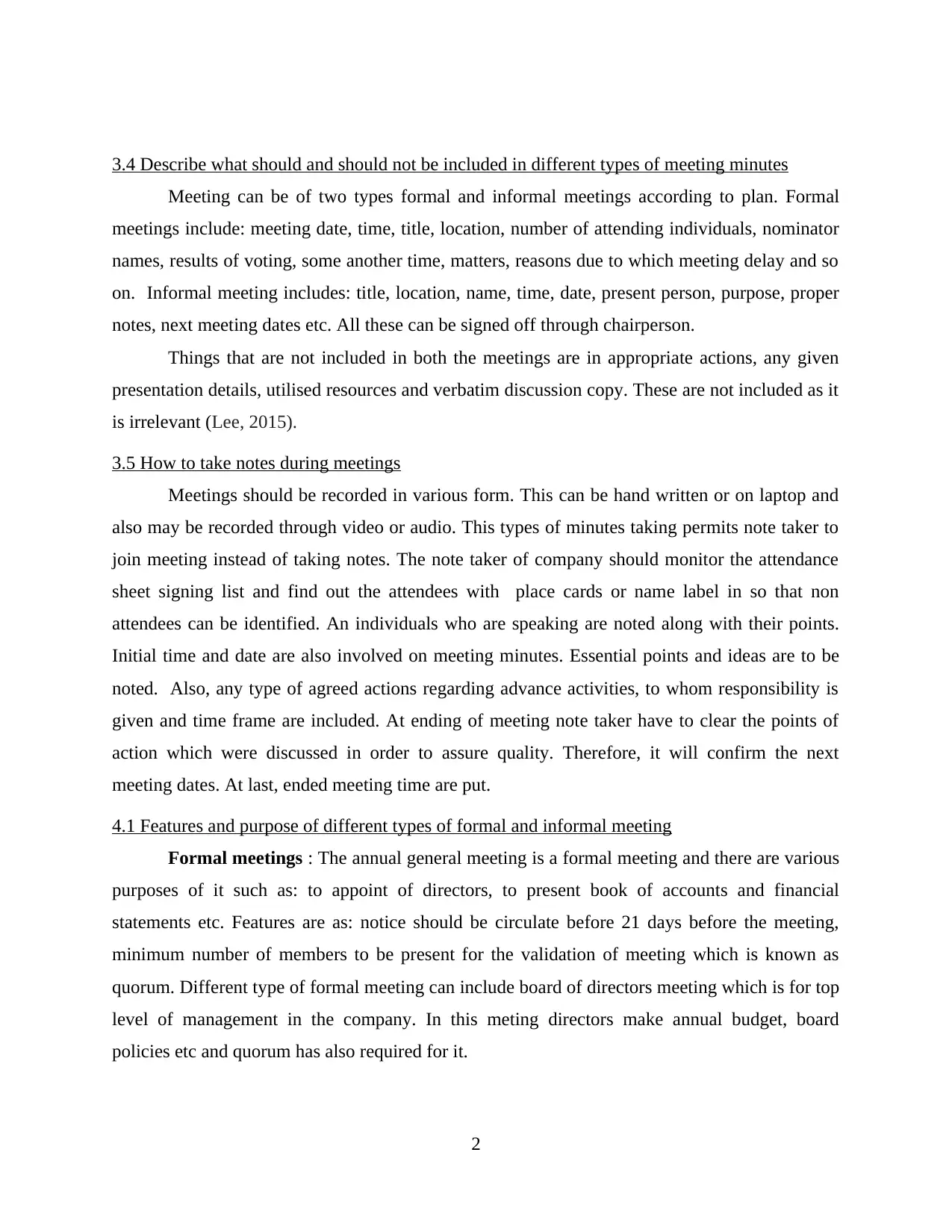
3.4 Describe what should and should not be included in different types of meeting minutes
Meeting can be of two types formal and informal meetings according to plan. Formal
meetings include: meeting date, time, title, location, number of attending individuals, nominator
names, results of voting, some another time, matters, reasons due to which meeting delay and so
on. Informal meeting includes: title, location, name, time, date, present person, purpose, proper
notes, next meeting dates etc. All these can be signed off through chairperson.
Things that are not included in both the meetings are in appropriate actions, any given
presentation details, utilised resources and verbatim discussion copy. These are not included as it
is irrelevant (Lee, 2015).
3.5 How to take notes during meetings
Meetings should be recorded in various form. This can be hand written or on laptop and
also may be recorded through video or audio. This types of minutes taking permits note taker to
join meeting instead of taking notes. The note taker of company should monitor the attendance
sheet signing list and find out the attendees with place cards or name label in so that non
attendees can be identified. An individuals who are speaking are noted along with their points.
Initial time and date are also involved on meeting minutes. Essential points and ideas are to be
noted. Also, any type of agreed actions regarding advance activities, to whom responsibility is
given and time frame are included. At ending of meeting note taker have to clear the points of
action which were discussed in order to assure quality. Therefore, it will confirm the next
meeting dates. At last, ended meeting time are put.
4.1 Features and purpose of different types of formal and informal meeting
Formal meetings : The annual general meeting is a formal meeting and there are various
purposes of it such as: to appoint of directors, to present book of accounts and financial
statements etc. Features are as: notice should be circulate before 21 days before the meeting,
minimum number of members to be present for the validation of meeting which is known as
quorum. Different type of formal meeting can include board of directors meeting which is for top
level of management in the company. In this meting directors make annual budget, board
policies etc and quorum has also required for it.
2
Meeting can be of two types formal and informal meetings according to plan. Formal
meetings include: meeting date, time, title, location, number of attending individuals, nominator
names, results of voting, some another time, matters, reasons due to which meeting delay and so
on. Informal meeting includes: title, location, name, time, date, present person, purpose, proper
notes, next meeting dates etc. All these can be signed off through chairperson.
Things that are not included in both the meetings are in appropriate actions, any given
presentation details, utilised resources and verbatim discussion copy. These are not included as it
is irrelevant (Lee, 2015).
3.5 How to take notes during meetings
Meetings should be recorded in various form. This can be hand written or on laptop and
also may be recorded through video or audio. This types of minutes taking permits note taker to
join meeting instead of taking notes. The note taker of company should monitor the attendance
sheet signing list and find out the attendees with place cards or name label in so that non
attendees can be identified. An individuals who are speaking are noted along with their points.
Initial time and date are also involved on meeting minutes. Essential points and ideas are to be
noted. Also, any type of agreed actions regarding advance activities, to whom responsibility is
given and time frame are included. At ending of meeting note taker have to clear the points of
action which were discussed in order to assure quality. Therefore, it will confirm the next
meeting dates. At last, ended meeting time are put.
4.1 Features and purpose of different types of formal and informal meeting
Formal meetings : The annual general meeting is a formal meeting and there are various
purposes of it such as: to appoint of directors, to present book of accounts and financial
statements etc. Features are as: notice should be circulate before 21 days before the meeting,
minimum number of members to be present for the validation of meeting which is known as
quorum. Different type of formal meeting can include board of directors meeting which is for top
level of management in the company. In this meting directors make annual budget, board
policies etc and quorum has also required for it.
2

Informal meeting : This type of meeting could be a department team meeting. Purpose
of this meeting is to receive updates on organisation information or its respective department.
Future plans are discussed in it. The main feature is that notice is not required for this meting.
The other formal meeting is project meeting which can be held to achieve the specific targets.
The main feature is that workers can be participate in the meeting (Lakhal and Frenette, 2015).
4.2 Role and responsibilities of the chair
In the meeting chair has various roles and responsibilities. The role is to make sure that
all members have arrived and signed in, control the meeting and forms the agenda order, setting
the pace. It ensue that all persons are discuss about useful and relevant points which brings a
valid conclusion. To dominate the discussion and interrupts to keep the meeting in specific order.
The chair is responsible to summarise the achievements and actions agreed and arrange the time
and date of next meeting. In the end it sign off the minutes from the meeting.
4.3 Role of others in a meeting
Other persons has following roles in a meeting such as: to review the agenda and minutes
of last meeting of organisation, to listen the attendance and participate in the group discussion,
ask questions related to the subject matter, give votes if they are agree towards the appointment
of a director or auditor. Make notes of valid points of discussion and give suggestion for the
improvements and ensure the actions are completed within the stipulated time duration and
prepare to report back at the next meeting which would be held in future.
4.4 Techniques to facilitate a meeting
To facilitate a meeting is about to ensure the meeting is effective and inclusive. The chair
is responsible the conduct a successful meeting and attendees provide support to keep it flowing .
Preparation is a key technique to facilitating the meeting. Agenda has to be pre planned so
persons know what will be matter of discussion and time, date and venue can be predetermined
and inform to the all members. Notice have to be place to the persons before the meeting and
responses have to be collected of various members at the end of meeting.
4.5 Information requirements of a meeting before, during and after a meeting
Time, data and venue, purpose and nature of meeting has been decided by the chairperson
and ensure the notice has been circulated to all members. During the meeting it is required to
make the list of attendance, to note the important points of group discussion, topic or subject
3
of this meeting is to receive updates on organisation information or its respective department.
Future plans are discussed in it. The main feature is that notice is not required for this meting.
The other formal meeting is project meeting which can be held to achieve the specific targets.
The main feature is that workers can be participate in the meeting (Lakhal and Frenette, 2015).
4.2 Role and responsibilities of the chair
In the meeting chair has various roles and responsibilities. The role is to make sure that
all members have arrived and signed in, control the meeting and forms the agenda order, setting
the pace. It ensue that all persons are discuss about useful and relevant points which brings a
valid conclusion. To dominate the discussion and interrupts to keep the meeting in specific order.
The chair is responsible to summarise the achievements and actions agreed and arrange the time
and date of next meeting. In the end it sign off the minutes from the meeting.
4.3 Role of others in a meeting
Other persons has following roles in a meeting such as: to review the agenda and minutes
of last meeting of organisation, to listen the attendance and participate in the group discussion,
ask questions related to the subject matter, give votes if they are agree towards the appointment
of a director or auditor. Make notes of valid points of discussion and give suggestion for the
improvements and ensure the actions are completed within the stipulated time duration and
prepare to report back at the next meeting which would be held in future.
4.4 Techniques to facilitate a meeting
To facilitate a meeting is about to ensure the meeting is effective and inclusive. The chair
is responsible the conduct a successful meeting and attendees provide support to keep it flowing .
Preparation is a key technique to facilitating the meeting. Agenda has to be pre planned so
persons know what will be matter of discussion and time, date and venue can be predetermined
and inform to the all members. Notice have to be place to the persons before the meeting and
responses have to be collected of various members at the end of meeting.
4.5 Information requirements of a meeting before, during and after a meeting
Time, data and venue, purpose and nature of meeting has been decided by the chairperson
and ensure the notice has been circulated to all members. During the meeting it is required to
make the list of attendance, to note the important points of group discussion, topic or subject
3
⊘ This is a preview!⊘
Do you want full access?
Subscribe today to unlock all pages.

Trusted by 1+ million students worldwide
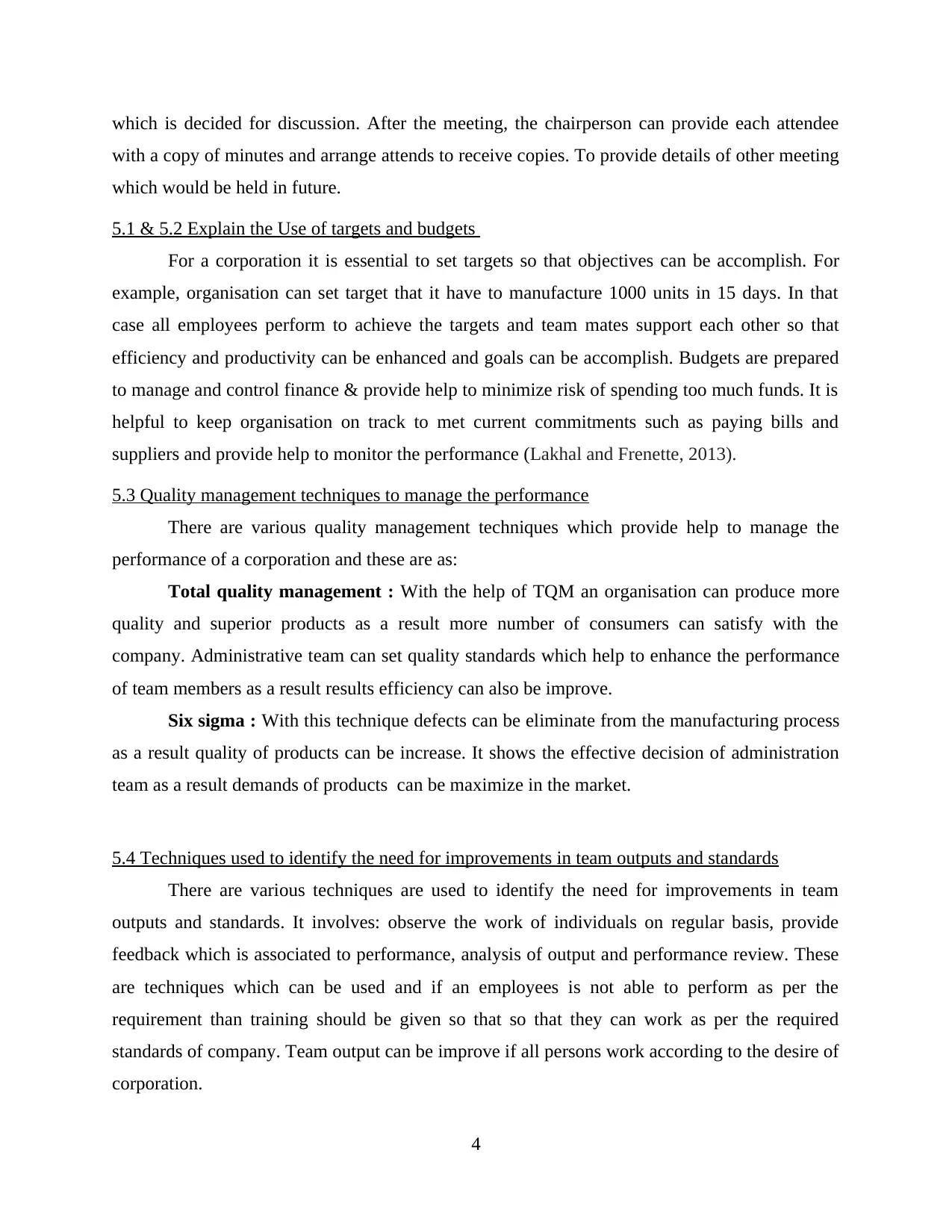
which is decided for discussion. After the meeting, the chairperson can provide each attendee
with a copy of minutes and arrange attends to receive copies. To provide details of other meeting
which would be held in future.
5.1 & 5.2 Explain the Use of targets and budgets
For a corporation it is essential to set targets so that objectives can be accomplish. For
example, organisation can set target that it have to manufacture 1000 units in 15 days. In that
case all employees perform to achieve the targets and team mates support each other so that
efficiency and productivity can be enhanced and goals can be accomplish. Budgets are prepared
to manage and control finance & provide help to minimize risk of spending too much funds. It is
helpful to keep organisation on track to met current commitments such as paying bills and
suppliers and provide help to monitor the performance (Lakhal and Frenette, 2013).
5.3 Quality management techniques to manage the performance
There are various quality management techniques which provide help to manage the
performance of a corporation and these are as:
Total quality management : With the help of TQM an organisation can produce more
quality and superior products as a result more number of consumers can satisfy with the
company. Administrative team can set quality standards which help to enhance the performance
of team members as a result results efficiency can also be improve.
Six sigma : With this technique defects can be eliminate from the manufacturing process
as a result quality of products can be increase. It shows the effective decision of administration
team as a result demands of products can be maximize in the market.
5.4 Techniques used to identify the need for improvements in team outputs and standards
There are various techniques are used to identify the need for improvements in team
outputs and standards. It involves: observe the work of individuals on regular basis, provide
feedback which is associated to performance, analysis of output and performance review. These
are techniques which can be used and if an employees is not able to perform as per the
requirement than training should be given so that so that they can work as per the required
standards of company. Team output can be improve if all persons work according to the desire of
corporation.
4
with a copy of minutes and arrange attends to receive copies. To provide details of other meeting
which would be held in future.
5.1 & 5.2 Explain the Use of targets and budgets
For a corporation it is essential to set targets so that objectives can be accomplish. For
example, organisation can set target that it have to manufacture 1000 units in 15 days. In that
case all employees perform to achieve the targets and team mates support each other so that
efficiency and productivity can be enhanced and goals can be accomplish. Budgets are prepared
to manage and control finance & provide help to minimize risk of spending too much funds. It is
helpful to keep organisation on track to met current commitments such as paying bills and
suppliers and provide help to monitor the performance (Lakhal and Frenette, 2013).
5.3 Quality management techniques to manage the performance
There are various quality management techniques which provide help to manage the
performance of a corporation and these are as:
Total quality management : With the help of TQM an organisation can produce more
quality and superior products as a result more number of consumers can satisfy with the
company. Administrative team can set quality standards which help to enhance the performance
of team members as a result results efficiency can also be improve.
Six sigma : With this technique defects can be eliminate from the manufacturing process
as a result quality of products can be increase. It shows the effective decision of administration
team as a result demands of products can be maximize in the market.
5.4 Techniques used to identify the need for improvements in team outputs and standards
There are various techniques are used to identify the need for improvements in team
outputs and standards. It involves: observe the work of individuals on regular basis, provide
feedback which is associated to performance, analysis of output and performance review. These
are techniques which can be used and if an employees is not able to perform as per the
requirement than training should be given so that so that they can work as per the required
standards of company. Team output can be improve if all persons work according to the desire of
corporation.
4
Paraphrase This Document
Need a fresh take? Get an instant paraphrase of this document with our AI Paraphraser
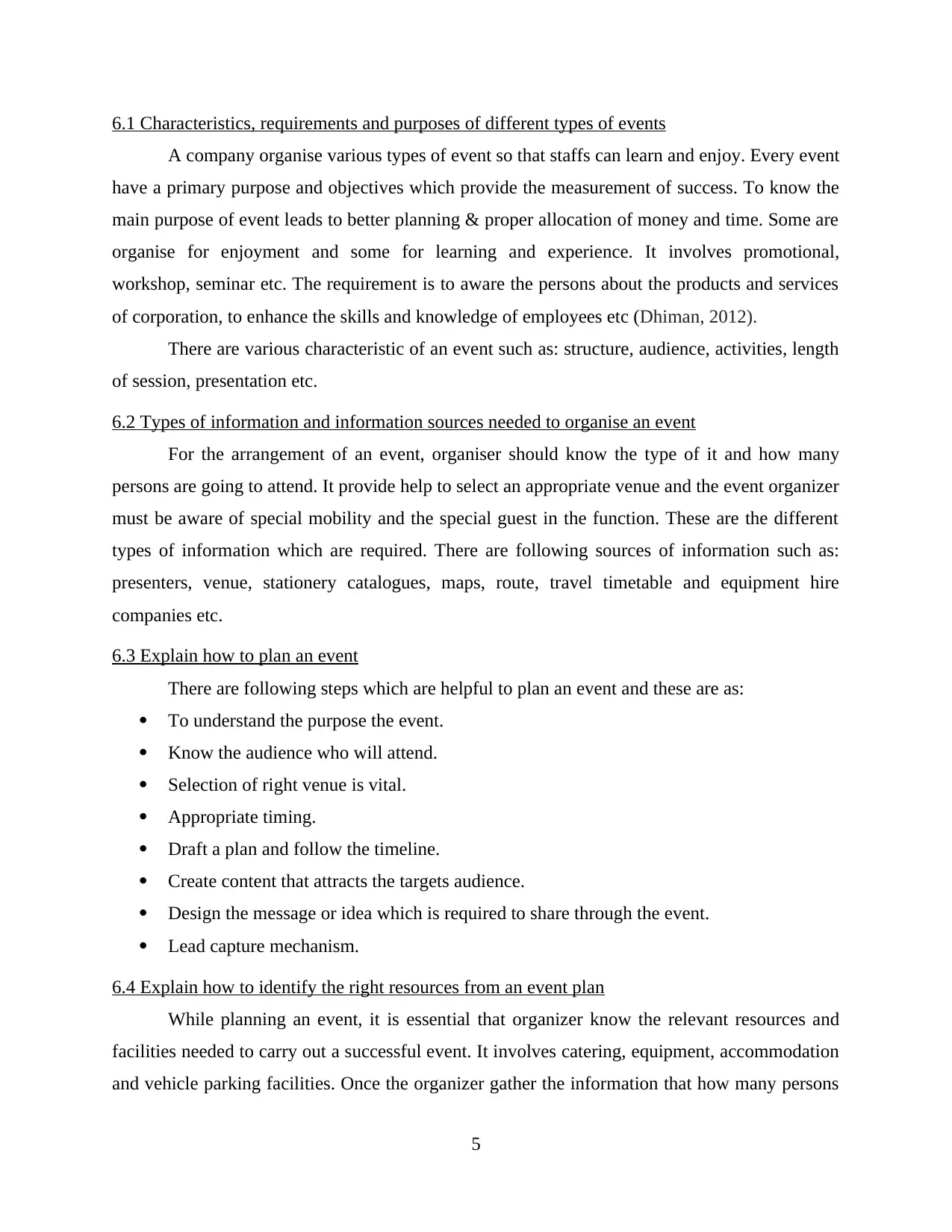
6.1 Characteristics, requirements and purposes of different types of events
A company organise various types of event so that staffs can learn and enjoy. Every event
have a primary purpose and objectives which provide the measurement of success. To know the
main purpose of event leads to better planning & proper allocation of money and time. Some are
organise for enjoyment and some for learning and experience. It involves promotional,
workshop, seminar etc. The requirement is to aware the persons about the products and services
of corporation, to enhance the skills and knowledge of employees etc (Dhiman, 2012).
There are various characteristic of an event such as: structure, audience, activities, length
of session, presentation etc.
6.2 Types of information and information sources needed to organise an event
For the arrangement of an event, organiser should know the type of it and how many
persons are going to attend. It provide help to select an appropriate venue and the event organizer
must be aware of special mobility and the special guest in the function. These are the different
types of information which are required. There are following sources of information such as:
presenters, venue, stationery catalogues, maps, route, travel timetable and equipment hire
companies etc.
6.3 Explain how to plan an event
There are following steps which are helpful to plan an event and these are as:
To understand the purpose the event.
Know the audience who will attend.
Selection of right venue is vital.
Appropriate timing.
Draft a plan and follow the timeline.
Create content that attracts the targets audience.
Design the message or idea which is required to share through the event.
Lead capture mechanism.
6.4 Explain how to identify the right resources from an event plan
While planning an event, it is essential that organizer know the relevant resources and
facilities needed to carry out a successful event. It involves catering, equipment, accommodation
and vehicle parking facilities. Once the organizer gather the information that how many persons
5
A company organise various types of event so that staffs can learn and enjoy. Every event
have a primary purpose and objectives which provide the measurement of success. To know the
main purpose of event leads to better planning & proper allocation of money and time. Some are
organise for enjoyment and some for learning and experience. It involves promotional,
workshop, seminar etc. The requirement is to aware the persons about the products and services
of corporation, to enhance the skills and knowledge of employees etc (Dhiman, 2012).
There are various characteristic of an event such as: structure, audience, activities, length
of session, presentation etc.
6.2 Types of information and information sources needed to organise an event
For the arrangement of an event, organiser should know the type of it and how many
persons are going to attend. It provide help to select an appropriate venue and the event organizer
must be aware of special mobility and the special guest in the function. These are the different
types of information which are required. There are following sources of information such as:
presenters, venue, stationery catalogues, maps, route, travel timetable and equipment hire
companies etc.
6.3 Explain how to plan an event
There are following steps which are helpful to plan an event and these are as:
To understand the purpose the event.
Know the audience who will attend.
Selection of right venue is vital.
Appropriate timing.
Draft a plan and follow the timeline.
Create content that attracts the targets audience.
Design the message or idea which is required to share through the event.
Lead capture mechanism.
6.4 Explain how to identify the right resources from an event plan
While planning an event, it is essential that organizer know the relevant resources and
facilities needed to carry out a successful event. It involves catering, equipment, accommodation
and vehicle parking facilities. Once the organizer gather the information that how many persons
5
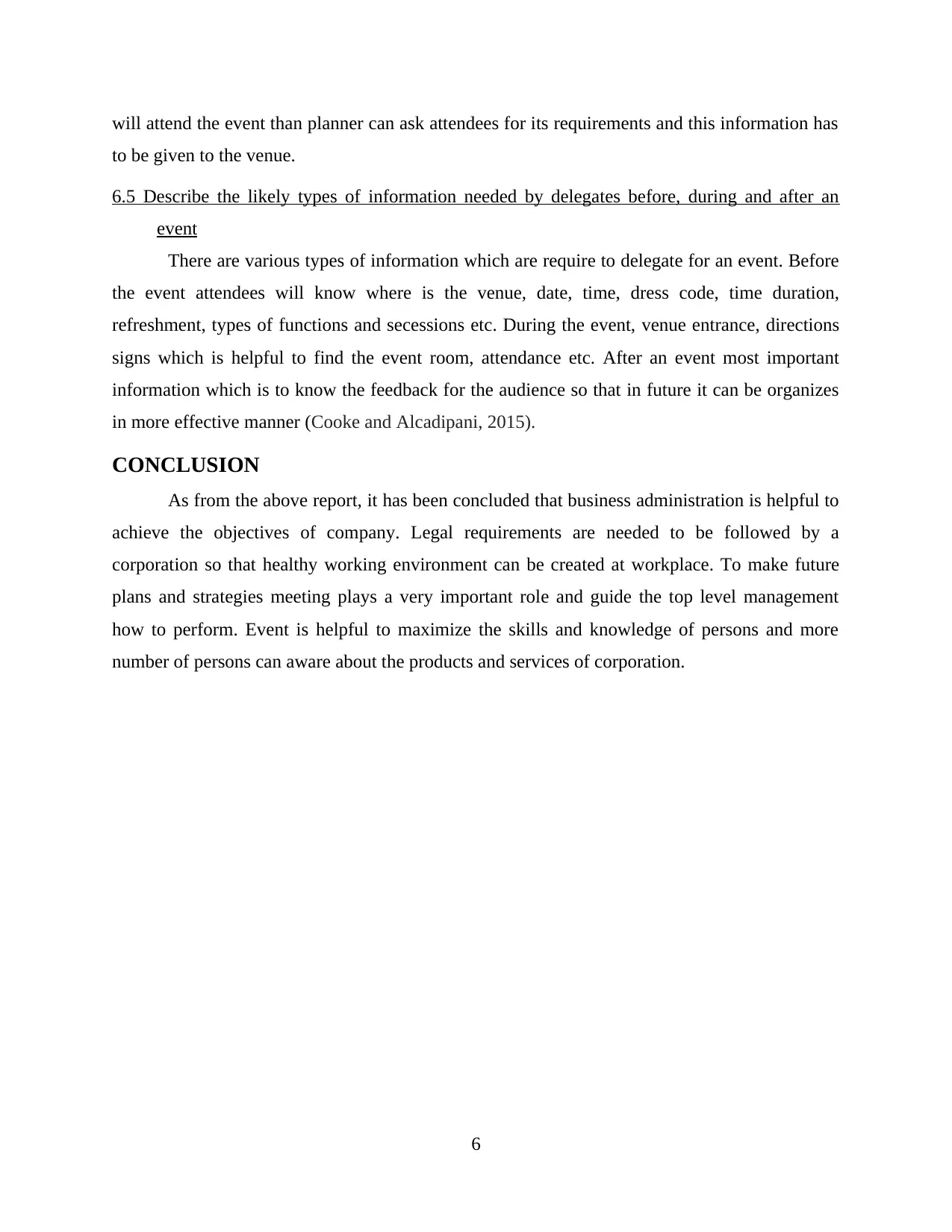
will attend the event than planner can ask attendees for its requirements and this information has
to be given to the venue.
6.5 Describe the likely types of information needed by delegates before, during and after an
event
There are various types of information which are require to delegate for an event. Before
the event attendees will know where is the venue, date, time, dress code, time duration,
refreshment, types of functions and secessions etc. During the event, venue entrance, directions
signs which is helpful to find the event room, attendance etc. After an event most important
information which is to know the feedback for the audience so that in future it can be organizes
in more effective manner (Cooke and Alcadipani, 2015).
CONCLUSION
As from the above report, it has been concluded that business administration is helpful to
achieve the objectives of company. Legal requirements are needed to be followed by a
corporation so that healthy working environment can be created at workplace. To make future
plans and strategies meeting plays a very important role and guide the top level management
how to perform. Event is helpful to maximize the skills and knowledge of persons and more
number of persons can aware about the products and services of corporation.
6
to be given to the venue.
6.5 Describe the likely types of information needed by delegates before, during and after an
event
There are various types of information which are require to delegate for an event. Before
the event attendees will know where is the venue, date, time, dress code, time duration,
refreshment, types of functions and secessions etc. During the event, venue entrance, directions
signs which is helpful to find the event room, attendance etc. After an event most important
information which is to know the feedback for the audience so that in future it can be organizes
in more effective manner (Cooke and Alcadipani, 2015).
CONCLUSION
As from the above report, it has been concluded that business administration is helpful to
achieve the objectives of company. Legal requirements are needed to be followed by a
corporation so that healthy working environment can be created at workplace. To make future
plans and strategies meeting plays a very important role and guide the top level management
how to perform. Event is helpful to maximize the skills and knowledge of persons and more
number of persons can aware about the products and services of corporation.
6
⊘ This is a preview!⊘
Do you want full access?
Subscribe today to unlock all pages.

Trusted by 1+ million students worldwide
1 out of 13
Related Documents
Your All-in-One AI-Powered Toolkit for Academic Success.
+13062052269
info@desklib.com
Available 24*7 on WhatsApp / Email
![[object Object]](/_next/static/media/star-bottom.7253800d.svg)
Unlock your academic potential
Copyright © 2020–2025 A2Z Services. All Rights Reserved. Developed and managed by ZUCOL.




